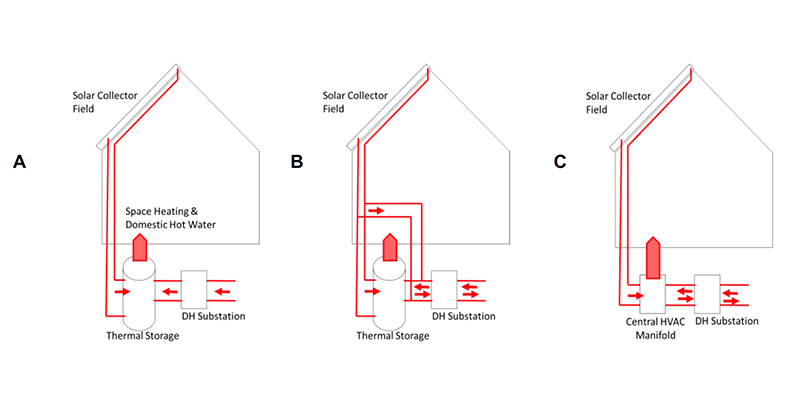Downloads
DOI:
https://doi.org/10.7480/jfde.2018.2.2085Keywords:
solar systems, thermal energy, building integration, energy systemsAbstract
In this paper, the energy performance of a solar thermal (ST) façade system is studied in relation to its connection to a district heating system. This concept allows for the direct use of ST heat in the building, while taking profit from the network for delivery/selling of excess heat and purchase of heat during periods of underproduction. The use of unglazed collectors for low-intrusive architectural interaction in façades is discussed.
Studies are carried out on the heat production of the system and its capacity to cope with local demands. Economic studies are carried out in order to balance the investment and operational costs/profits of the system.
How to Cite
Published
Issue
Section
License
Copyright (c) 2018 Mikel Lumbreras Mugaguren, Roberto Garay, Koldobika Martin

This work is licensed under a Creative Commons Attribution 4.0 International License.
Authors or their institutions retain copyright to their publications without restrictions.
References
Ehsanul, K., Kumar, P., Kumar, S., Adelodun, A. A., & Kim, K. (2018). Solar energy: Potential and future prospects. Renewable and Sustainable Energy Reviews, Volume 82, Part 1, pp. 894-900, ISSN 1364-0321, https://doi.org/10.1016/j.rser.2017.09.094.
Código Técnico de la Edificación [Technical Building Code] (CTE) (2013). Documento Básico de Ahorro de Energía [Basic Document of Energy Saving] (DB-HE). Retrieved from https://www.codigotecnico.org/images/stories/pdf/ahorroEnergia/DBHE.pdf
Monsalvete Álvarez de Uribarri, P., Eicker, U., & Robinson, D. (2017). Energy performance of decentralized solar thermal feed-in to district heating networks. Energy Procedia, Volume 116, Pages 285-296, ISSN 1876-6102, https://doi.org/10.1016/j.egypro.2017.05.075.]
Stickney, B. & Soifer, B, (2009). Solar Thermal Hydronic Collector Comparison and Selection. Retrieved from http://solarprofessional.com/articles/products-equipment/solar-heating/solar-thermal-hydronics#.WoF68emWzxM
Duffie, J.A. & Beckman, W.A. (1980). Solar Engineering of Thermal Processes (Second edition). New York: John Wiley & Sons, Inc.
O’Hegarty, R, Kinnane, O., & McCormack, S.J. (2016). Review and analysis of solar thermal façades. Solar Energy,Volume 135, pp 408-422, ISSN 0038-092X
Giovanardi, A. (2012), integrated solar thermal façade component for building energy retrofit. Eurac research.
Garay Martinez, R., Arregi Goikolea, B., Bonnamy, P., & Lopez, J. (2017). Concept, development and thermal characterization of an unglazed solar thermal collector for façade integration. Dyna ingenieria e industria. 92. pp466-472. 10.6036/8108.
Sanchez Zabala, V., & Garay Martinez, R. (2017). Design of consumer thermal substations for the integration of distributed solar technologies in district heating systems.
Kottek, M., Grieser, J., Beck, C., Rudolph, B., & Rubel, F. (2006), World Map of the Köppen-Geiger climate classification updated, Meteorologische Zeitschrift, Vol.15, No. 3, 259-263
UNE-EN ISO 13790:2011, Energy performance of buildings - Calculation of energy use for space heating and cooling (ISO 13790:2008)
Solar Collector Factsheet (2012), Energie Solaire Kollektor AS. Retrieved from https://www.energie-solaire.com/jt_files/pdf/scf1209de.pdf
Harris, R. (2018). Value Creation, Net Present Value and Economic Profit. Darden business publishing. University of California
Precio centro Guadalajara [Price center Guadalajara]. Visited in 2018. Retrieved from http://preciocentro.com/tienda/productos-edicion-2017/55-base-edificacion-urbanizacion-2017.html [CD-ROM].
Tarifa de precios solar térmica Salvador Escoda [Salvador Escoda solar thermal price list] (2018). Retrieved from http://www.salvadorescoda.com/tarifas/Energias_Renovables_Tarifa_PVP_SalvadorEscoda.pdf
Tarifs de Vente CPCU [Sales Rates CPCU], (2016). Retrieved from http://www.cpcu.fr/Qui-sommes-nous/Documentations-CPCU
RELaTED, REnewable Low TEmperature District, EU h2020 GA nº 768567 (2017-2021), retrieved from www.relatedproject.eu
